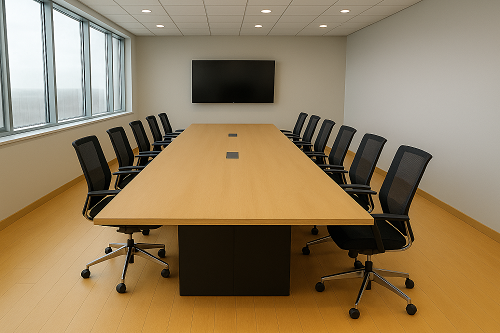Conference rooms are the heart of collaboration in modern offices. The flooring you select not only influences aesthetics but also impacts acoustics, comfort, durability, and maintenance demands. A well-chosen floor can enhance speech clarity, support heavy foot and chair traffic, and reflect your brand identity.
1. Key Performance Criteria
- Acoustic Performance: Minimizing echoes and noise transfer is essential for clear communication. Flooring materials differ widely in their sound absorption coefficients.
- Durability & Resilience: Conference rooms see constant foot traffic and rolling chairs. Floors must resist scratches, dents, and wear over time.
- Comfort & Ergonomics: Comfort underfoot affects fatigue during long meetings. Consider underlayments, cushioning, and thermal properties.
- Maintenance & Cleanability: Some surfaces repel stains and dust, while others demand periodic deep cleaning or refinishing.
- Aesthetics & Brand Alignment: Flooring conveys style—warm and inviting or sleek and minimal.
- Sustainability & Health: Low-VOC materials and eco-friendly options contribute to healthier indoor air quality and reduced environmental impact.
2. Flooring Options: Detailed Analysis
2.1 Carpet & Carpet Tiles
Advantages:
- Superior Acoustic Absorption: Significantly reduces reverberation and footstep noise.
- Modular Replacement: Tiles allow spot replacements without full reinstallation.
- Comfort: Soft texture eases fatigue.
Challenges:
- Cleaning Requirements: Accumulates dust; requires vacuuming and occasional shampooing.
- Moisture Sensitivity: Susceptible to staining and mold if spills aren’t addressed promptly.
Best Practices:
- Opt for high-density, low-pile carpets with antimicrobial backing.
- Combine with an acoustic underlay (e.g., rubber or felt) to boost performance.
2.2 Luxury Vinyl Tile (LVT) & Plank (LVP)
Advantages:
- High Durability: Scratch- and stain-resistant; ideal for rolling chairs.
- Design Variety: Realistic wood, stone, or abstract patterns.
- Low Maintenance: Simple sweeping and damp mopping.
Challenges:
- Acoustic Limitations: Hard surface reflects sound; requires underlayment.
- Subfloor Requirements: Must be perfectly level to avoid telegraphed imperfections.
Best Practices:
- Install with an acoustic cork or foam underlay rated for 19+ IIC (Impact Insulation Class).
- Choose LVT with a thick wear layer (20 mil or higher) for high-traffic zones.
2.3 Hardwood & Engineered Wood
Advantages:
- Premium Aesthetic: Timeless appearance enhances corporate image.
- Longevity: Solid hardwood can be sanded and refinished multiple times.
Challenges:
- Cost: Higher upfront and maintenance expense.
- Noise Transmission: Hard underfoot; requires area rugs or wall treatments.
Best Practices:
- Pick engineered wood with a robust top veneer for dimensional stability.
- Apply area rugs or use acoustic ceiling panels to offset echo.
2.4 Laminate Flooring
Advantages:
- Cost-Effective: Wood-look at a fraction of hardwood’s price.
- Scratch Resistance: Durable melamine wear layer.
Challenges:
- Irreplaceable Wear Layer: No refinishing; must replace planks when worn.
- Hollow Sound: Needs quality underlayment to prevent noise.
Best Practices:
- Use high-density fiberboard (HDF) core varieties.
- Pair with a 3–5 mm acoustic underlay.
2.5 Polished Concrete & Epoxy Coatings
Advantages:
- Ultra-Durable: Minimal wear over decades.
- Low Maintenance: Seamless surface; easy to mop.
Challenges:
- Hard, Cold Surface: Can be uncomfortable; tends to echo.
- Design Limitations: Less warmth; may need area rugs.
Best Practices:
- Incorporate radiant floor heating for comfort.
- Install ceiling baffles or wall panels for acoustic control.
3. Comparative Matrix
| Feature | Carpet Tiles | LVT/LVP | Hardwood | Laminate | Polished Concrete |
| Acoustic Performance |
★★★★★ |
★★★☆☆ |
★★☆☆☆ |
★★☆☆☆ |
★☆☆☆☆ |
| Durability |
★★★★☆ |
★★★★★ |
★★★☆☆ |
★★★☆☆ |
★★★★★ |
| Comfort |
★★★★★ |
★★★☆☆ |
★★★★☆ |
★★★☆☆ |
★★☆☆☆ |
| Maintenance |
★★☆☆☆ |
★★★★☆ |
★★★☆☆ |
★★★★☆ |
★★★★★ |
| Aesthetic Flexibility |
★★★★☆ |
★★★★★ |
★★★★☆ |
★★★★☆ |
★★★☆☆ |
4. Installation & Budgeting
- Site Assessment: Check subfloor flatness, moisture levels, and HVAC layout.
- Sample Testing: Order material samples—evaluate color, texture, slip resistance.
- Professional Installation: Ensure certified installers follow manufacturer guidelines.
Budget Breakdown:
- Materials (per m²/ft²)
- Underlay & adhesives
- Labor
- Maintenance (annual cleaning/refinishing)
5. Sustainability Considerations
- Cradle-to-Cradle Certifications: Look for floors certified for recyclability.
- Low-VOC Options: Ensure adhesives and finishes meet indoor air quality standards (e.g., GreenGuard).
- Recycled Content: Many LVT and carpet tiles incorporate recycled fibers/plastics.
Selecting the right conference-room flooring is a strategic decision that balances acoustics, durability, comfort, aesthetics, maintenance, and sustainability. By understanding each material's strengths and limitations—and by tailoring your choice to specific use patterns and brand objectives—you can create a polished, comfortable environment that empowers effective collaboration.
Ready to get started? Define your top priorities (noise control, budget, style) and request samples today!


































